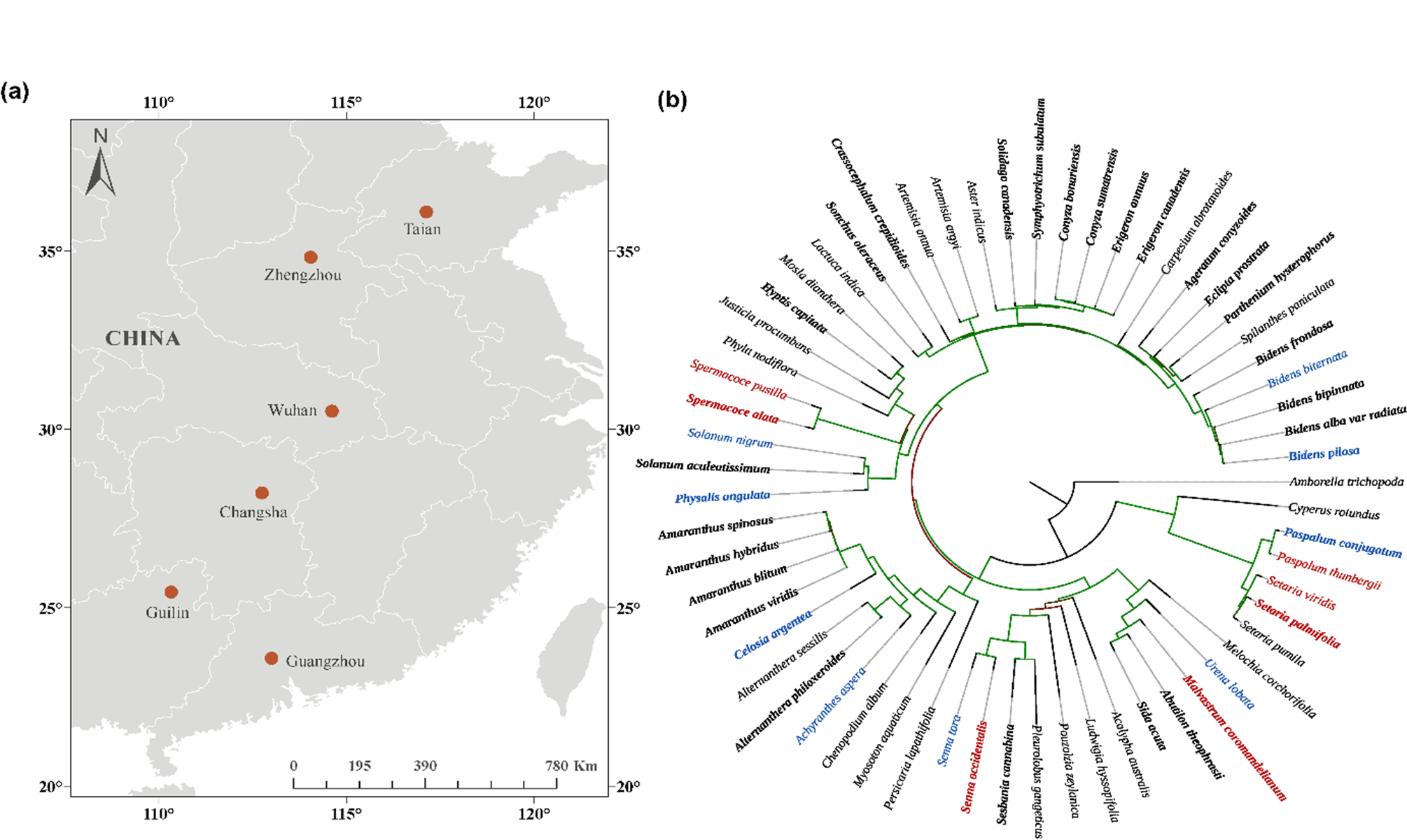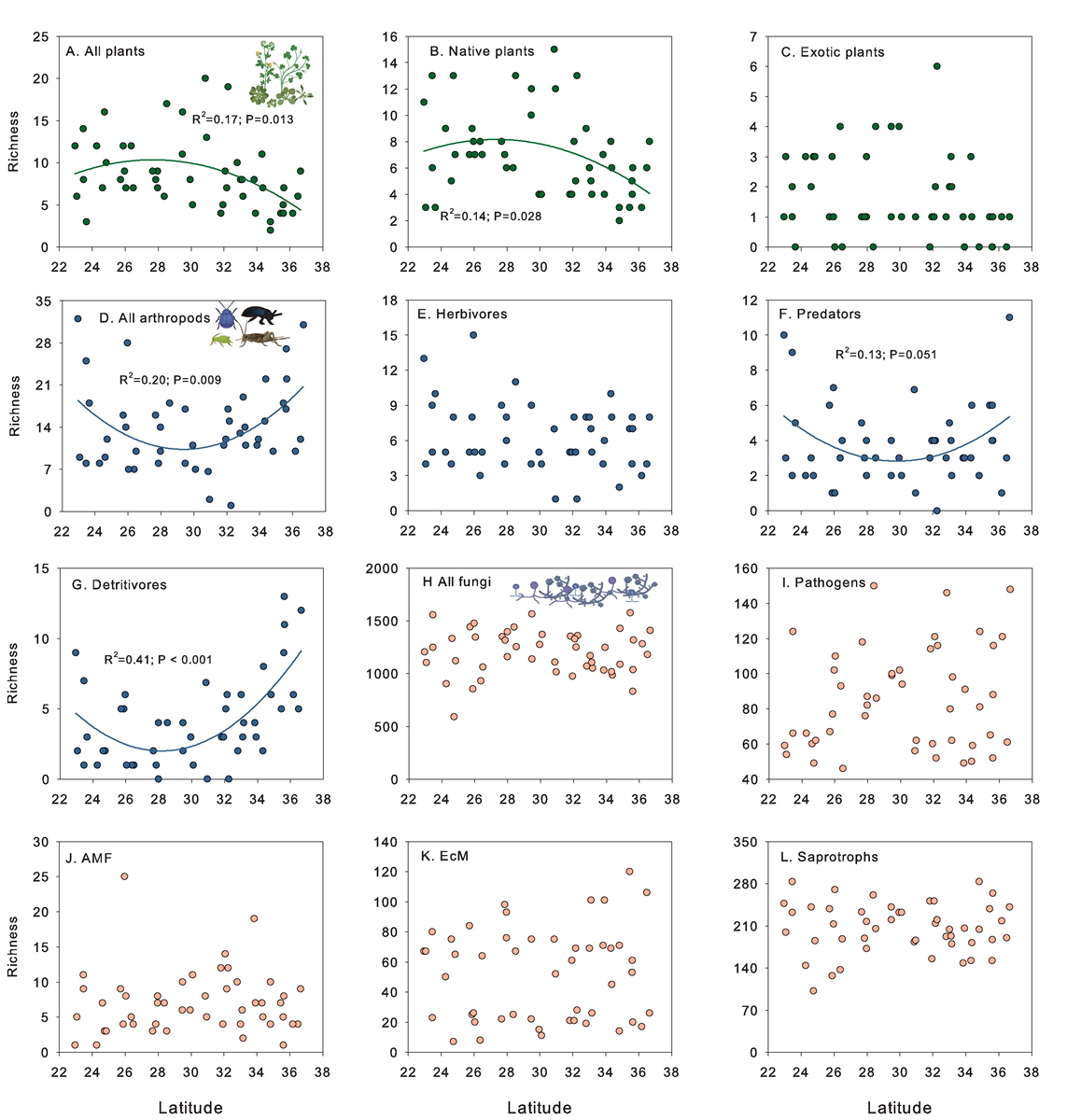
图1. 野外调查样点(a)和本研究所涉及植物物种的系统发育关系(b)

图 2 不同生物群落丰富度纬度变化规律
南湖新闻网讯(通讯员 高伦伦)我校植物科学技术学院教授、农业微生物国家重点实验室PI卢新民课题组首次采用生物地理学和植物系统发育研究框架,综合纬度梯度野外调查和温室控制实验,比较了我国常见且共发生的60余种入侵和本土植物根际真菌群落结构(图1)。该成果以“Plant evolution overwhelms geographical origin in shaping rhizosphere fungi across latitudes”为题发表于Global Change Biology杂志。
研究发现,植物根际真菌群落结构主要由植物系统发育关系决定,而植物来源(入侵或本土)和非生物环境(如气候、土壤理化性状)等的影响较弱;入侵和本土植物根际特异性真菌OUT的丰富度和相对含量均无显著差异;北纬25.2-29.2之间,入侵植物种间根际真菌群落组成差异较本土植物种间根际真菌群落种间差异大。这些发现不支持天敌逃逸假说、植物入侵导致本土生物均质化等观点,表明本土生物能够快速适应外来入侵生物形成新的相互作用。
课题组成员以入侵植物喜旱莲子草为对象,开展纬度梯度调查(跨14个纬度、49个样点),首次探讨了与入侵植物共存的不同生物群落纬度变化规律及其驱动因子。结果发现,由于对气候和生物因子(如植物入侵)变化的响应存在差异,与喜旱莲子草共存的植物(包括本土和外来植物)、节肢动物(包括草食动物、捕食性动物和食腐动物等)和土壤真菌(包括致病真菌、共生真菌和腐生真菌等)的多样性和组成呈现不同的纬度格局(图2);与气候比较,植物入侵和其他生物因子对一些生物类群(如土壤致病真菌)多样性和组成具更强的调控作用。研究表明,气候和外来植物入侵同步调控生物群落组成,但两者相对作用强度因生物类群不同而有所差异。该成果以“Latitudinal variation in the diversity and composition of various organisms associated with an exotic plant: the role of climate and plant invasion”为题发表于New Phytologist杂志。
课题组博士生韦春强和高伦伦为Global Change Biology文章的共同第一作者;博士生高伦伦、韦春强和硕士生徐浩为New Phytologist文章的共同第一作者。昆虫教研室刘晓艳副教授参与部分研究,卢新民教授为两篇论文的通讯作者。上述研究得到国家自然科学基金、中央高校基本科研业务费专项资金和高层次人才启动经费等项目的资助。
审核人:卢新民
发表于Global Change Biology论文【英文摘要】
As the number of non-native invasive species in the world is increasing, there is a pressing need to understand the effects of invasive species on recipient biotic communities to improve our ability to migrate or relieve their potential negative effects on biodiversity and ecosystem functions. Plant invasions have been shown to impose great threats to aboveground biotic communities; however, invasive impacts on soil biota remain ambiguous, partially because of the paucity of studies with large number of species across biogeographic gradients. Here, we characterized rhizosphere fungal communities of 53 native and invasive plants spanning approximately 1800 km in China, as well as 8 pairs of phylogenetically related native vs. invasive plants in a greenhouse experiment. The results of both field survey and greenhouse experiment showed that rhizosphere fungal composition was primarily predicted by plant phylogeny (e.g., family and species), and plant geographic origin (native vs. invasive) and abiotic factors had much smaller effects. We detected no differences in the number and relative abundance of total and family/species-specific OTUs (i.e., overall, pathogens and mutualists) associated with these native and invasive plants on average, suggesting novel co-evolution between native soil fungi and these invasive plants. These results suggest that non-native plant invasions had only a weak impact on soil biota, partially due to stronger controls of plant evolution on root microbiomes and adaptation of native fungi to these invasive species. Interestingly, rhizosphere fungal composition was more variable between invasive plants than between native plants at middle latitudes, potentially creating spatial variations in plant-soil interactions and, in turn, invasion dynamics. These novel findings highlight the importance of integrating phylogenetic and biogeographical approaches to explore invasive effects on native biota.
论文链接:https://doi.org/10.1111/gcb.15683
发表于New Phytologst论文【英文摘要】
Climate and plant invasion can shape biotic communities at large spatial scales. Yet, how diverse groups of organisms associated with an invasive plant change simultaneously with latitude and roles of climate and plant invasion remains unclear.
We conducted a field survey of plants (native vs. exotic), soil fungi (pathogenic, saprotrophic, AM and EcM fungi) and arthropods (herbivores, predators and detritivores) associated with the invasive plant Alternanthera philoxeroides at 49 sites spanning 14 latitudinal degrees in China.
Results showed that diversity and composition of these functional groups changed differently with latitude, partially due to their specific responses to climate, invasion of A. philoxeroides and other biotic environments. Moreover, A. philoxeroides invasion and/or composition of other plants, rather than climate, predicted the diversity and richness of major functional groups and partly explained variance in composition of putative fungal pathogens.
Our results suggest that climate and plant invasion could affect the diversity and composition of diverse groups of organisms simultaneously and their relative importance might vary among functional groups. Thus, it is necessary to explore latitudinal patterns and underlying drivers of diverse groups of organisms simultaneously to improve our ability to predict and mitigate threats posed by plant invasion and climate change.

